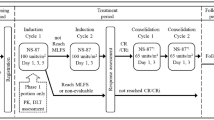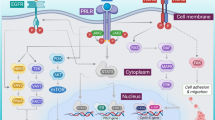Summary
Calmodulin antagonists, such as trifluoperazine, can enhance the cytotoxic effects of bleomycin both in tissue culture and in vivo. Therefore, we evaluated the effects of combination treatment with these drugs in a phase I clinical trial. Patients with objectively measurable or evaluable cancer refractory to conventional treatment who had an acceptable performance status (ECOG 0-2) and acceptable laboratory studies were eligible. All patients gave written informed consent. A cycle of therapy consisted of three weekly treatments with trifluoperazine (days 1–4) and 30 IU bleomycin (day 3). After three patients completed a cycle of therapy without experiencing dose-limiting toxicity, new patients were entered in the study and received a higher dose of trifluoperazine. The dose of bleomycin remained constant. Evaluable patients received at least 2 weeks of treatment and survived for 6 weeks; of 19 patients, 2 were unevaluable. The major toxicities were neurological and pulmonary and included one case of fatal pneumonia with interstitial pulmonary fibrosis. There was no hematologic toxicity. Two patients underwent partial responses (PRs) and two had complete responses (CRs). We conclude that trifluoperazine can safely by given with bleomycin and that further study of the potential efficacy of this treatment is indicated.
Similar content being viewed by others
References
Blum RH, Carter SK, Agve K (1973) A clinical review of bleomycin—a new antineoplastic agent. Cancer 31:903
Boynton AL, Whitfield JF, MacManus JP (1980) Calmodulin stimulates DNA synthesis in rat liver cells. Biochem Biophys Res Commun 95:745
Braverman IM, Yager NB, Chen M, Cadman EC, Hait WN, Maynard T (1987) Combined total body electron beam irradiation and chemotherapy for mycosis fungoides. J Am Acad Dermatol 16:45
Chafouleas JA, Bolton WE, Means AR (1984) Potentiation of bleomycin lethality by anticalmodulin drugs: a role for calmodulin in DNA repair. Science 224:1346
Cheung WY (1980) Calmodulin plays a pivotal role in cellular regulation. Science 207:19
Cohen P, Burchill A, Foulkes JG, Cohen PTW, Vanaman TC, Narin AC (1978) Identification of the Ca-dependent modulator protein as the fourth subunit of rabbit skeletal muscle phosphorylase kinase. FEBS Lett 92:287
Fisher RI, DeVita VT Jr, Hubbard SM, Longo DL, Wesley R, Chabner B, Young RC (1983) Diffuse aggressive lymphomas: increased survival after alternating flexible sequences of Pro-MACE and MOPP chemotherapy. Ann Intern Med 98:304
Ganapathi R, Grabowski D (1983) Enhancement of sensitivity to adriamycin in resistant P 388 leukemia by the calmodulin inhibitor trifluoperazine. Cancer Res 43:3696
Gopinath RM, Vincenzi FF (1977) Phosphodiesterase protein activator mimics red blood cell cytoplasmic activator of Ca2+-Mg2+-ATPase. Biochem Biophys Res Commun 17:1203
Hait WN, Lazo JS (1986) Calmodulin: a potential target for cancer chemotherapeutic agents. J Clin Oncol 4:994
Hait WN, Lee GL (1985) Characterization of the cytotoxic effects of the phenothiazine class of calmodulin antagonists. Biochem Pharmacol 34:3973–3978
Hait WN, Grais L, Benz C, Cadman EC (1985) Inhibition of growth of leukemic cells by inhibitors of calmodulin: phenothiazines and melittin. Cancer Chemother Pharmacol 14:202
Hait, WN, Lazo JS, Chen D-L, Gallichio VS, Filderman AE (1988) Antitumor and toxic effects of combination chemotherapy with bleomycin and a phenothiazine anticalmodulin agent. J Natl Cancer Inst 80:246
Hickie RA, Klaassen DJ, Carl GZ, Meyskens FL Jr, Kreutzfeld KL, Thomson SP (1984) Anticalmodulin agents as inhibitors of human tumor cell clonogenicity. In: Salmon SE, Trent JM (eds) Human tumor cloning. Grune & Stratton, New York, p 409
Jarrett HW, Penniston JT (1977) Partial purification of the Ca2+-Mg2+-ATPase activator from human erythrocytes: its similarity to the activator of 3′,5′-cyclic nucleotide phosphodiesterase. Biochem Biophys Res Commun 71:1210
Jones A, Boynton AL, MacManus JP, Whitfield JF (1982) Ca2+-calmodulin mediates the DNA-synthetic response of calcium-deprived liver cells to the tumor promoter TPA. Exp Cell Res 138:87
Kennedy KA, Hait WN, Lazo JS (1986) Chemical modulation of bleomycin induced toxicity. Int J Radiat Biol Biophys 12: 1367
Lazo JS, Hait WN, Kennedy KA, Braun ID, Meandzija B (1985) Enhanced bleomycin-induced DNA damage and cytotoxicity with calmodulin antagonists. Mol Pharmacol 27:387
Lazo JS, Chen D-L, Gallicchio VS, Hait WN (1986) Increased lethality of calmodulin antagonists and bleomycin to human bone marrow and bleomycin-resistant malignant cells. Cancer Res 46:2236
Lee GL, Hait WN (1984) Inhibition of growth of C6 astrocytoma cells by inhibitors of calmodulin. Life Sci 36:347
Levin RM, Weiss B (1976) Mechanisms by which psychotropic drugs inhibit adenosine cyclic 3′,5′-monophosphate phosphodiesterase of brain. Mol Pharmacol 12:581
MacDonal JS, Schein PS, Wooley PV, Smythe T, Winston U, Hoth D, Frederick S, Boiron M, Gisselbrecht C, Brunet R, Lagarde C (1980) 5-Fluorouracil, mitomycin-C and adriamycin (FAM): a new combination chemotherapy program for advanced gastric carcinoma. Ann Intern Med 93:533
Marcum JM, Dedman JR, Brinkley BR, Means AR (1978) Control of microtubule assembly0disassembly by the calcium-dependent regulator protein. Proc Natl Acad Sci USA 75: 3771
Means AR, Chafouleas JA, Lagace L, Lai E, Stein JP (1982) Multiple roles for calmodulin in the regulation of eukaryotic cell metabolism. In: O'Malley (ed) Gene regulation. UCLA Symposium on Molecular and Cellular Biology. Academic Press, New York, p 307
Meltzer HY, Kare JM, Kolakowskat T (1983) Plasma levels of neuroleptics, prolactin levels, and clinical response. In: Coyle T, Enna JJ (eds) Neuroleptics, neurochemistry, behavioral and clinical response. Raven Press, New York
Miller RL, Bukowski RM, Budd GT, Purvis J, Weick JK, Shepard K, Midha KK, Ganapathi R (1987) Clinical modulation of doxorubicin resistance by the calmodulin inhibitor, trifluoperazine: a phase I/II trial. J Clin Oncol 6:880–888
Schulman H, Greengard P (1978) Ca2+-dependent protein phosphorylation system in membranes from various tissues and its activation by “calcium-dependent regulator”. Proc Natl Acad Sci USA 75:5432
Tsuruo T, Iida H, Tsukagoshi S, Sakurai Y (1981) Overcoming of vincristine resistance in P388 leukemia in vivo and in vitro through enhanced cytotoxicity of vincristine and vinblastine by verapamil Cancer Res 41:1967
Wei JW, Hickie RA, Klassen DJ (1983) Inhibition of human breast cancer colony formation by anti-calmodulin agents: trifluoperazine, W-7, and W-13. Cancer Chemother Pharmacol 11:86
Yang SD, Tallant EA, Cheung WY (1982) Calcineurin is a calmodulin-dependent protein phosphatase. Biochem Biophys Res Commun 106:1419
Author information
Authors and Affiliations
Additional information
This work was supported by grants from Bristol-Meyers, the National Cancer Institute (CAO8341, CA-4388), and the American Cancer Society (CH302A)
Dr. Hait is a Burroughs Wellcome Scholar in Clinical Pharmacology
Rights and permissions
About this article
Cite this article
Hait, W.N., Morris, S., Lazo, J.S. et al. Phase I trial of combined therapy with bleomycin and the calmodulin antagonist, trifluoperazine. Cancer Chemother. Pharmacol. 23, 358–362 (1989). https://doi.org/10.1007/BF00435836
Received:
Accepted:
Issue Date:
DOI: https://doi.org/10.1007/BF00435836




